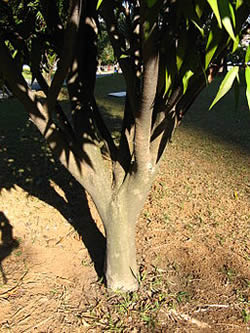Andiroba Carapa guianensis
- Common Names
- Andiroba Oil
- Botanical Name
- Carapa guianensis
- Family
- MELIACEAE
Medicinal Uses & Benefits of Andiroba Oil
![]() How to Use|
Side Effects |
Plant & Garden|
How to Use|
Side Effects |
Plant & Garden|
- Properties: * Anti-inflammatory * Astringent * EFA * Vermifuge * Vulnerary
- Parts Used: Oil extracted from the nut, bark and leaves
- Constituents: andirobin, arachidic acid, acetoxy-gedunins, epoxyazadiradiones, deacetoxygedunins, hydroxylgedunins, gedunins, hexadecenoic acid, linoleic acid, linolenic acid, oleic acid, palmitic acid, palmitoleic acid, and stearic acid
How to Use: Andiroba
Andiroba oil is an anti-inflammatory oil rich in omega-3 fatty acids that promote skin healing from cuts and may slow the growth of skin cells in psoriasis and age spots. It promotes normal circulation to the skin and relieves pain and swelling. Andiroba oil is used in heated massage to relieve arthritis.,1
The Northwest Amazons use the bark and leaves for fever-reducing and worm-inhibiting tea, and externally as a wash for skin problems, ulcers, and insect bites, and as an insect repellent.2
Preparation Methods & Dosage :Use the slightly heavy oil in heated massage to relieve pain and stiffness. Andiroba oil can be applied liberally several times daily. Use this oil externally to relieve the pain of sore muscles and joints of arthritis. For skin conditions, andiroba oil can be used to stop the itching of insect bites, as an insect repellent, and to treat more serious skin conditions like psoriasis and eczema. Use a few drops directly in the ear for ear infections and ear pain. Mix 2ml in a glass of warm water as a gargle for sore throats.
Plant Description
- Flowers:fragrant
- Tree:Rain forest tree reaching heights of 300 ft, closely related to mahogany
- Leaves:
- Fruit: Brown, woody, four-cornered nut, chestnut like in appearance, oil-rich kernel
- Preferred Habitat:
- Distribution:Tropical rainforests of Brazil, Colombia, and Guyana
History and Traditions & Folklore
The people of the Amazon also use andiroba oil to treat pulled muscles and as fuel in oil lamps for illumination. Candles are also made with andiroba oil to repel mosquitoes. The Caboclo Indians of Maraho Island utilize the oil topically for insect bites and ear infections; they use a decoction of the bark internally to stimulate digestion.2 In Brazil, the fruit oil is used internally to treat cough and applied topically to remove ticks. Andiroba is also used by the forest-dwellers and river people of the Amazon in the production of a medicinal soap.2- Bell, Stacey; Balch, CNC, Phyllis A. (2012-04-03). Prescription for Herbal Healing, 2nd Edition: An Easy-to-Use A-to-Z Reference to Hundreds of Common Disorders and Their Herbal Remedies (p. 22). Penguin Group. Kindle Edition.
Andiroba oil may accelerate healing of skin damage by providing myristic acid, one of the chemical building blocks of an enzyme that links together the proteins that form the skin�s protective outer layer. One of the fatty acids found in andiroba oil, linolenic acid, was shown in a laboratory study to slow the growth of skin cells in psoriasis and age spots.
- Andiroba,Carapa guianensis. American Botanical Council











